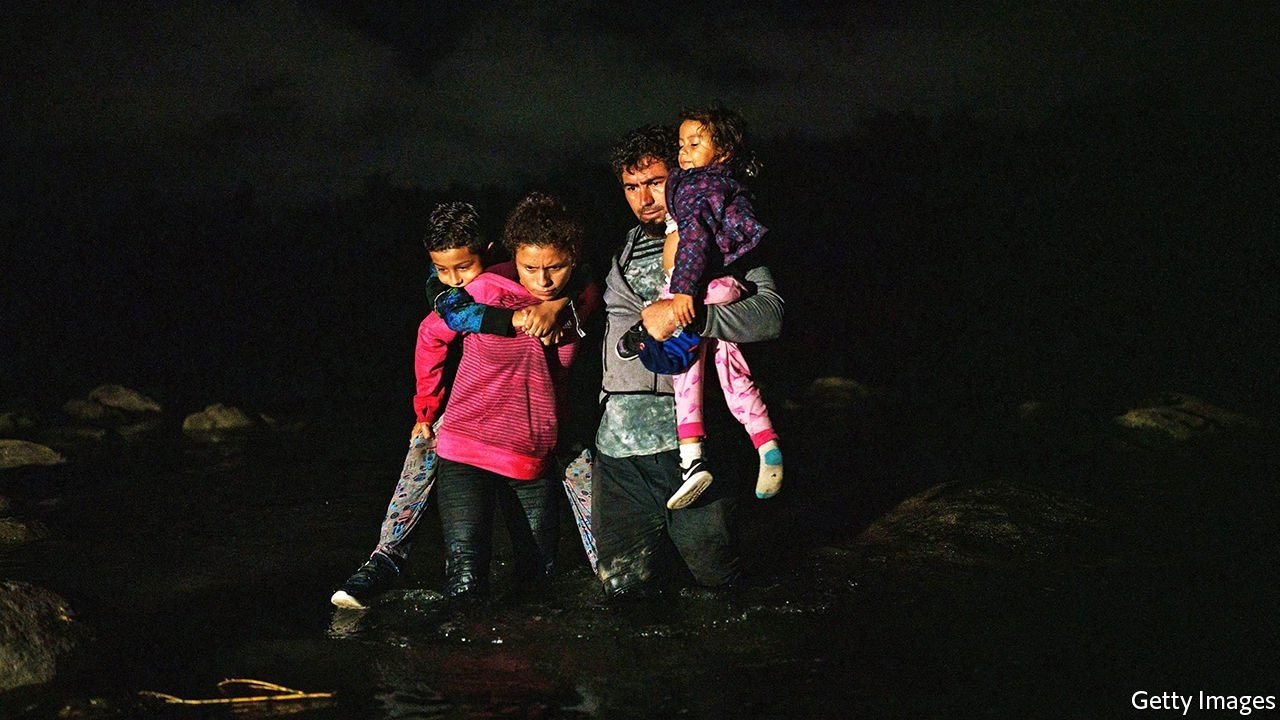WHEN THE Turkish coastguard found them in the Aegean in the dead of night, they had been adrift for three hours. The air was hissing out of their rubber dinghy. The motor would not start. Anas and the eight other Somali men shielded their eyes from the glare of the searchlights. His wife, Faduma, the only woman, panted from stress and exhaustion. They had paid $2,000 apiece to a smuggler to reach Greece. Faduma, six months pregnant, was the first to climb onto the Turkish boat.
That was the couple’s first attempt to reach Europe after leaving Somalia last year. “We are never going do this again,” Anas says. He hopes to stay in Turkey.
Some 11,000km (7,000 miles) away, in Tijuana, Mexico, another couple try to cross a forbidding border. José and María, who did not want to give their real names, fled El Salvador after José appealed to police for help in recovering stolen cows. The gang behind the theft threatened to kill María and their young son. With help from a sister living in America they paid a smuggler $10,000 to bring them to Texas, where they turned themselves in to the border patrol and asked for asylum. The agents expelled them to the desert near Juárez. That was a “devastating” moment, says José.
José and María made their way by bus west to Tijuana, where they live with dozens of other families in tents in a shelter. Instead of Salvadorean criminals they contend with Mexican ones. María says a man tried to grab her son as she was shopping for food. In May, when this conversation took place, José and María were still set on getting to America. “Most of all,” says María, “we want a chance for our son to grow up in a place that’s safe.”
Anas, Faduma, José and María are caught up in a global backlash against a treaty that has just turned 70. The refugee convention, adopted on July 28th 1951, governs the obligations that states have to people who flee their countries because of a “well-founded fear” of persecution “for reasons of race, religion, nationality, membership of a particular social group or political opinion”. States must not send them back to danger, a principle called non-refoulement. America incorporated the treaty’s language in the Refugee Act of 1980.
Some nationalist politicians have no interest in meeting the duties imposed by the convention. Among Donald Trump’s first acts as America’s president was to shut the country’s doors to refugees from some Muslim countries, prompting Germany’s chancellor, Angela Merkel, to “explain” the convention to him. Others struggle with the political difficulties of doing so. A jump in the number of asylum-seekers on America’s southern border was among the first crises faced by his successor, Joe Biden. Europe’s big surge, in 2015, boosted populist parties and contributed to Britain’s vote for Brexit a year later.
Politicians are still traumatised by the angry public reaction. The Netherlands’ Liberals, led by the prime minister, Mark Rutte, suggest withdrawing from the convention. The immigration spokesman of Denmark’s ruling Social Democratic party recently told people to “stop seeking asylum” in his country. The treaty “doesn’t provide a travel card to go to whichever country a refugee or asylum-seeker wants,” says Notis Mitarachi, Greece’s migration minister. It may be the least popular treaty in the rich world.

If the convention has provoked a backlash, that is largely because the world has changed since its adoption. The original treaty applied only to Europeans who had been displaced by the second world war and the onset of the cold war. A protocol adopted in 1967 made its provisions global and applied them to future refugee crises. After the treaty’s scope was widened the number of refugees grew (see chart). Many of today’s asylum-seekers are fleeing violence in weak states rather than the sort of tyranny that dominated wartime Europe.
Last year, despite the pandemic’s brake on migration, 1.4m people sought protection outside their home countries; nearly 10m were forcibly displaced within them. That brought the total number of forcibly displaced people to 82.4m, the highest on record. About 30m are refugees or asylum-seekers—people asking for refugee status. “The demands on the refugee system are absolutely unprecedented,” says Gillian Triggs of the UN’s refugee agency (UNHCR).
They are bound to grow, and further strain adherence to the septuagenarian treaty. A big reason is that refugees are hard to distinguish from the much larger group of migrants who just want to improve their lives. If everyone who wants to move could, America’s population would increase by 46% and Germany’s by 45%, according to a “potential net-migration index” put together by Gallup, a pollster. Motivations for migrating are becoming more complex. A West African fisherman might head north because his catch has fallen, but then run up debts to people-smugglers or wind up in a Libyan detention centre and so become a refugee, points out Petra Suric of the International Rescue Committee (IRC), an NGO. The effects of climate change may force 143m people to move by 2050, says the World Bank. That is already posing problems for interpreters of a treaty written with the Nazis’ victims in mind.

Luckily for jumpy Western politicians, 86% of refugees (including displaced Venezuelans) are in developing countries (see map). Nearly three-quarters are in countries next to the ones they fled from. That is unlikely to change. But even the relatively few asylum-seekers who make it to rich countries can up-end their politics.
When a couple like José and María show up visa-less, they trigger both sympathy and suspicion. Are they dodging immigration laws or fleeing peril? Is it the sort of peril that is grounds for offering protection under the refugee convention and a mesh of other treaties? The answer might differ by country. Mexico subscribes to the Cartagena declaration of 1984, which calls on states to protect people threatened by “generalised violence”, which is easier to prove than persecution. America does not. Unlike poorer parts of the world, America, Europe and Australia have elaborate systems for assessing whether individual migrants deserve asylum. But they are creaky, and suspicion is prevailing over sympathy. “The huge majority applying for asylum are not refugees,” says Ylva Johansson, the EU’s home affairs commissioner.
Mr Trump’s administration separated migrant parents from their children, forced asylum-seekers to remain in Mexico to await hearings on their claims and signed “safe-third-country” agreements with Central American countries, giving responsibility to determine who is a genuine refugee to governments ill equipped to do so. His Justice Department directed immigration courts which, unusually for the rich world, are answerable to politicians, to narrow their interpretation of refugee law. Women no longer counted as members of a particular social group. Victims of gangs had to show that their government would not or could not protect them. Title 42, a pandemic policy, allows border agents to deport migrants to protect public health. Between October 2020 and June 2021 some 1m expulsions, including that of José and María, took place under this policy. Summary removals are “a clear violation” of the convention, says Erika Pinheiro of Al Otro Lado, an NGO.
America has the world’s largest immigration detention system, which currently holds 27,000 people. Immigration courts have a backlog of 1.4m cases, nearly half pertaining to asylum claims. The “labyrinth” offers no right to counsel, notes Olga Byrne of IRC. Yet in the years-long wait for a court date, asylum-seekers become part of American society and are rarely deported if their claims are denied. That encourages more to try their luck.
Europe’s handling of refugees is bedevilled by buck-passing. Germany and Sweden were exceptions in 2015 when they welcomed 1.4m refugees, but even they had second thoughts after far-right parties made gains by denouncing this openness. Undocumented migrants who land on the shores of Italy and Greece are supposed to apply for asylum there. The Mediterranean states, with the EU’s help, have shifted responsibility to non-European neighbours.
Europe’s most conspicuous act of buck-passing—“externalisation”, in the argot—is the EU-Turkey deal. In exchange for €6bn ($7bn) plus progress on liberalising visa rules for Turks and on Turkey’s bid to join the EU, Turkey agreed to take back “irregular migrants”. The number of Aegean crossings plunged from 860,000 in 2015 to 36,000 the following year. The arrangement was what thwarted Anas and Faduma. It exemplifies much of what is wrong with Europe’s approach to refugees, but it may also point to ways in which it could work better in the future.
From pillar to post
The deal led to the establishment of “hotspots”, which prevent asylum-seekers who made it to Greek islands from progressing further into Europe and make it easier to deport them to Turkey. The government reduced their size after a fire last year destroyed a camp on Lesbos. Now most of the 48,000 refugees and asylum-seekers in Greece are in camps on the mainland, where families live in converted shipping containers and single men share tents with dozens of others. Women fear using the communal loos at night. Covid-19 has kept children out of school. The government has tried to avoid granting asylum to the trapped migrants, creating a backlog of applications that peaked at 140,000 last year.
When the Turkish coastguard fails to intercept Greece-bound migrants, the Greek one steps in. Epaminondas Farmakis of HumanRights360, a Greek NGO, estimates that 1,000 people a month are being pushed back or returned to sea. Louay Al Nassour, a Syrian, recounts that in March last year the Greek coastguard towed his boat to Rhodes, where the passengers were locked up in a warehouse. The next evening the coastguard took them back to sea, forced them into inflatable rafts without paddles and abandoned them. A Turkish coastguard vessel picked them up. Mr Nassour got back into Greece across the Evros river and is now in a camp.
Mr Mitarachi is keen to combat the impression that Greece is trampling on asylum-seekers’ rights. He denies that Greece is pushing them back and insists that the country complies with the refugee convention. He says he wants to eliminate the backlog, which has now fallen to about 50,000. In 2020 Greece’s asylum service gave 34,000 people refugee status or another form of protection. Officials expect some 50,000 eventually to settle there.
Turkey, with eight times Greece’s population, hosts more than 80 times as many refugees and migrants—3.7m Syrians and at least 300,000 migrants from countries such as Afghanistan and Somalia. It signed the convention but with a “geographical limitation” that obliges it to protect only refugees who come from Europe. Its grant of protection to Syrians cannot be trusted because it depends on political decisions, says Minos Mouzourakis of Refugee Support Aegean, an NGO. Human-rights groups allege that Turkey has deported thousands of Syrians. The deal helps prop up Turkey’s authoritarian leader, Recep Tayyip Erdogan.
Syrians enjoy more rights in Turkey than other migrants, but are not fully accepted. Just 30,000 have work permits, obliging most to work illegally. They are four times more likely to have been sacked during the pandemic than Turkish citizens, according to TEPAV, a think-tank. Yet they are finding a place. Initially housed in camps, most now live in cities. In Sanliurfa and Gaziantep, close to the Syrian border, they are a fifth of the population. They are entitled to education and health care, paid for partly by the EU. In a survey conducted in 2019, 89% of Syrian migrants said they felt at least partially integrated. Turkey has naturalised 100,000 of them.
To some advocates of refugees’ rights the EU-Turkey deal is a calamity. Mare Liberum, an organisation that watches out for human-rights abuses in the Aegean, called its fifth anniversary in March “shameful”. Others see in it the germ of an approach that balances the West’s asylum-aversion with refugees’ needs. The EU-Turkey deal is the main real-world example of “transnational asylum”, an idea put forward by Nikolas Feith Tan of the Danish Institute for Human Rights, who defines it as two states co-operating to process asylum claims or protect refugees. But, he cautions, the agreement is unacceptable without Turkey’s full adherence to the convention. People are looking at what might be called smart externalisation as the “next frontier” of asylum, says Susan Fratzke of the Migration Policy Institute (MPI) in Washington. What is needed are “anchors”—opportunities for refugees in the poor countries they flee to—“not walls” barring them from rich ones, says Alexander Betts, author of “The Wealth of Refugees”, a recent book.
Anchors are implicit in the “global compact on refugees”, adopted by the UN in 2018, which emphasises “responsibility-sharing” among countries. It casts refugees not just as charity cases but as contributors to and beneficiaries of the economic development of their hosts. The World Bank plans to lend $500m to Colombia, which in February gave temporary protection to more than 1m Venezuelans. The money will help it provide public services to them. The bank is also financing projects such as upgrading Djibouti’s schools for refugees and citizens.
But, keen as rich countries are on the idea that refugees should stay as close to home as possible, they do relatively little to help the countries that host them. On average, the gap between what the UNHCR asks for to meet refugees’ immediate needs and what donors give is around 45%, the agency estimates. The UN’s World Food Programme said last month that it will stop food aid for 21,000 Syrian refugees in Jordan “due to funding shortages”. Britain has cut its goal for development aid from 0.7% of its gross national income to 0.5%.
It is not just more money that is needed. Few rich countries are resettling lots of refugees, ie, handpicking them for relocation from poorer countries. Such resettlement will benefit a small minority, but it is important both in its own right and as a signal to host countries. “Europe is mistaken if it thinks it can exclusively support other countries to host refugees without hosting a fair number itself,” says Catherine Woollard of the European Council on Refugees and Exiles, an NGO network.
Not my responsibility
And Western countries continue to duck their obligations to the migrants who do manage to reach their borders. Improving the speed and efficiency of vetting such asylum-seekers would help governments repatriate those who can be sent home safely. “The credibility of the asylum system breaks down if you don’t find practical ways of returning people,” says Ms Triggs. To shrink the pile of cases in American immigration courts, MPI suggests transferring responsibility for deciding cases to the immigration service’s specialised asylum officers. When claims fail, America’s government could work with governments and NGOs in the applicants’ home countries to smooth their return.
Mr Biden seems open to such changes. He has begun to wind down Mr Trump’s war on refugees. Although Title 42 is still in force, America has stopped expelling unaccompanied children and ended Mr Trump’s remain-in-Mexico policy. The Justice Department is once again considering victims of domestic and gang violence for asylum. The White House proposes to expand processing of refugees within Central America for eventual resettlement in America, a form of transnational asylum. After saying he would stick with Mr Trump’s low target for resettling refugees—15,000 this year—Mr Biden raised it to 62,500.

Officially, Europe remains welcoming. “I don’t want to build a Fortress Europe,” says Ms Johansson. Some European countries are upgrading their asylum systems. In its proposed “pact” on migration, the EU claims to combine sensitivity with speed. Asylum-seekers who seem to have good claims will have their applications assessed by the established systems, but those who come from countries whose citizens are rarely accepted as refugees will be swiftly returned. To ensure that that happens, the EU wants to appoint a “return co-ordinator”, a new role.
Such an official may be necessary if the signatories of the refugee convention are to honour it. But “return” can easily breach the principle of non-refoulement, its main obligation. To avoid traducing the treaty as it turns 70, governments will have to spend more money and show more courage than they have done so far.
Source: Economist



